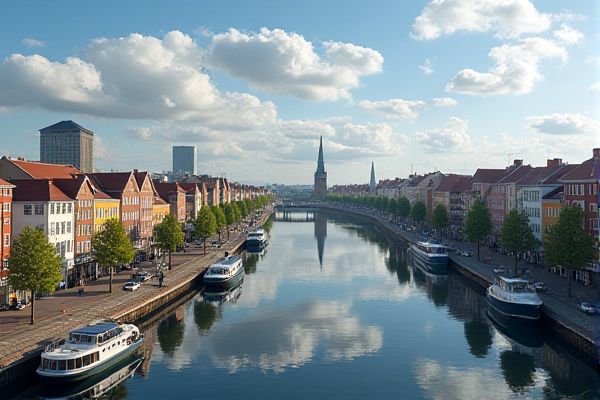
Moving to Denmark checklist: Understand Danish visa requirements. Research cost of living. Secure housing in advance. Familiarize with Danish healthcare system. Register for CPR number. Open a Danish bank account. Learn basic Danish phrases. Know public transportation options. Explore Danish job market. Pack for Denmark's climate.
Understand Danish visa requirements.
To move to Denmark, it's essential to know that U.S. citizens require a visa for stays exceeding 90 days. The application process involves applying and paying the visa fee online, submitting the necessary documents, and possibly attending an interview at the Danish Consulate General. Processing times generally take about 15 days but can extend up to 45 days in certain cases. For more detailed information, the most important source is the VFS Global Denmark USA official website, which provides comprehensive guidance on the application procedures and requirements.
Research cost of living.
Exploring the cost of living in Denmark reveals that the expenses for accommodation can range from 4,000 to 6,000 DKK for singles and up to 15,000 DKK for couples. Additionally, one must account for supplementary expenses such as food, which can cost between 1,500 and 2,000 DKK, transportation ranging from 200 to 800 DKK, utilities spanning 1,000 to 1,500 DKK, and entertainment expenses that amount from 500 to 1,000 DKK per month. These costs can vary significantly, influenced by city and lifestyle choices. For those interested in detailed insights about living expenses in the country, the [Cost of Living in Denmark](https://www.godigit.com/guides/cost-of-living/cost-of-living-in-denmark) provides useful information on financial requirements when planning to move or stay in different Danish cities.
Secure housing in advance.
To secure housing in advance in Denmark, it's crucial to start your accommodation search early, particularly in high-demand cities such as Copenhagen, Odense, or Aalborg. Utilize housing websites like BoligPortal and DBA, and be prepared to pay a deposit equivalent to three months' rent. It's important to sign a lease agreement that outlines all terms and responsibilities. For more comprehensive guidance, visiting the Deel Blog can provide valuable insights for expats moving to Denmark.
Familiarize with Danish healthcare system.
In Denmark, the healthcare system is universal and decentralized, with all residents entitled to publicly financed care, including primary, specialist, hospital, mental health, and long-term care services. The system is organized into three administrative levels: the national government, regions, and municipalities, with general practitioners acting as gatekeepers and no out-of-pocket payments for primary or specialty care consultations for those in Group 1 coverage. For more details on how this is managed, visit the Commonwealth Fund website.
Register for CPR number.
To register for a CPR number in Denmark, you must apply online after obtaining an EU registration certificate or residence permit, provide necessary documents such as a passport, proof of address, and employment contract, and pick up your CPR number in person at a Citizen Service Centre. Your stay must exceed three months, and you must have a permanent address in Denmark. For more detailed information, you can visit the official Ishoj website which provides comprehensive guidance on the CPR registration process.
Open a Danish bank account.
To open a Danish bank account, you need a photo ID, a CPR number, proof of address in Denmark, and sometimes proof of employment or student status. You can start the process online, but some banks may require an in-person visit to complete the verification, especially if you don't have a NemID or MitID. For more information on how to open a bank account, check out the detailed guide on the N26 Blog that provides step-by-step instructions and valuable tips for expats and locals alike.
Learn basic Danish phrases.
When embarking on the journey of learning basic Danish phrases, utilizing resources like Duolingo and Babbel can provide an immersive experience with their interactive lessons and speech recognition technology, crucial for mastering pronunciation and vocabulary retention. Babbel, in particular, stands out as a valuable tool, offering a plethora of useful Danish phrases that cover a range of practical scenarios such as greetings, ordering food, and navigating daily interactions. These platforms ensure a comprehensive language learning experience, enhancing your ability to communicate effectively. For further insights on enhancing your Danish language skills, you might find this Danish Resources blog exceptionally resourceful, as it delves deeper into various learning techniques and tools.
Know public transportation options.
Public transportation in Denmark includes a variety of options such as trains (S-tog and inter-city), buses, the metro in Copenhagen, and harbour buses. Tickets can be purchased through the DOT Mobilbilletter app, ticket machines, or online, providing options like single tickets, 24-hour cards, travel cards, and City Passes, all operating within a zone-based system. For more comprehensive information on navigating the public transport network, you can visit the Denmark Days website. This array of transportation options ensures efficient and accessible travel throughout the country.
Explore Danish job market.
To explore the Danish job market, utilize resources like Workindenmark, which provides a labour exchange and relevant information for both foreign jobseekers and Danish employers. Key sectors with high demand include Engineering, ICT, Life Science, and Healthcare, with job vacancies listed on platforms like Jobnet and Workindenmark.dk.
Pack for Denmark's climate.
When moving to Denmark, it is crucial to pack according to the season, including warm and waterproof clothing for winter, layered and waterproof items for spring and autumn, and lightweight clothing with layers for summer. Along with these seasonal essentials, items like a waterproof jacket, comfortable shoes, and versatile accessories are vital to adapt to the unpredictable climate. For more specific guidance, consult the detailed list of tips and essentials provided on the Denmark Days website, which offers practical advice for each season, ensuring a smooth transition to Danish living.
